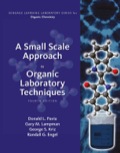
Interpretation:
The reason for 2-bromobutane to react faster than 2-chlorobutane in the test ofsilver nitrate with ethanol and
Concept Introduction:
Answer to Problem 1Q
In 2-bromobutane, -Br is a better leaving group than −Cl therefore it reacts faster than 2-chlorobutane.
Explanation of Solution
Given information:
Both 2-bromobutane and 2-chlorobutane give positive test with silver nitrate with ethanol and KI with acetone.
In 2-bromobutane, -Br is a better leaving group than −Cl therefore it reacts faster than 2-chlorobutane. The −Br leaving group is a weak base therefore it is a good leaving group compare to −Cl which is a stronger base and weak leaving group.
Hence 2-bromobutane reacts faster than 2-chlorobutane with silver nitrate with ethanol and
In 2-bromobutane, -Br is a better leaving group than −Cl therefore it reacts faster than 2-chlorobutane.
Want to see more full solutions like this?
Chapter 19 Solutions
EBK A SMALL SCALE APPROACH TO ORGANIC L
- Indicate the formula of the product obtained by reacting methyl 5-chloro-5-oxopentanoate with 1 mole of 4-penten-1-ylmagnesium bromide.arrow_forwardIn the two chair conformations of glucose, the most stable is the one with all the OH groups in the equatorial position. Is this correct?arrow_forwardIndicate the formula of the product obtained by reacting D-Galactose with hydroxylamine.arrow_forward
- helparrow_forwardThe temperature on a sample of pure X held at 1.25 atm and -54. °C is increased until the sample boils. The temperature is then held constant and the pressure is decreased by 0.42 atm. On the phase diagram below draw a path that shows this set of changes. pressure (atm) 2 0 0 200 400 temperature (K) Xarrow_forwardQUESTION: Answer Question 5: 'Calculating standard error of regression' STEP 1 by filling in all the empty green boxes *The values are all provided in the photo attached*arrow_forward

 Organic ChemistryChemistryISBN:9781305580350Author:William H. Brown, Brent L. Iverson, Eric Anslyn, Christopher S. FootePublisher:Cengage Learning
Organic ChemistryChemistryISBN:9781305580350Author:William H. Brown, Brent L. Iverson, Eric Anslyn, Christopher S. FootePublisher:Cengage Learning Chemistry for Today: General, Organic, and Bioche...ChemistryISBN:9781305960060Author:Spencer L. Seager, Michael R. Slabaugh, Maren S. HansenPublisher:Cengage Learning
Chemistry for Today: General, Organic, and Bioche...ChemistryISBN:9781305960060Author:Spencer L. Seager, Michael R. Slabaugh, Maren S. HansenPublisher:Cengage Learning


